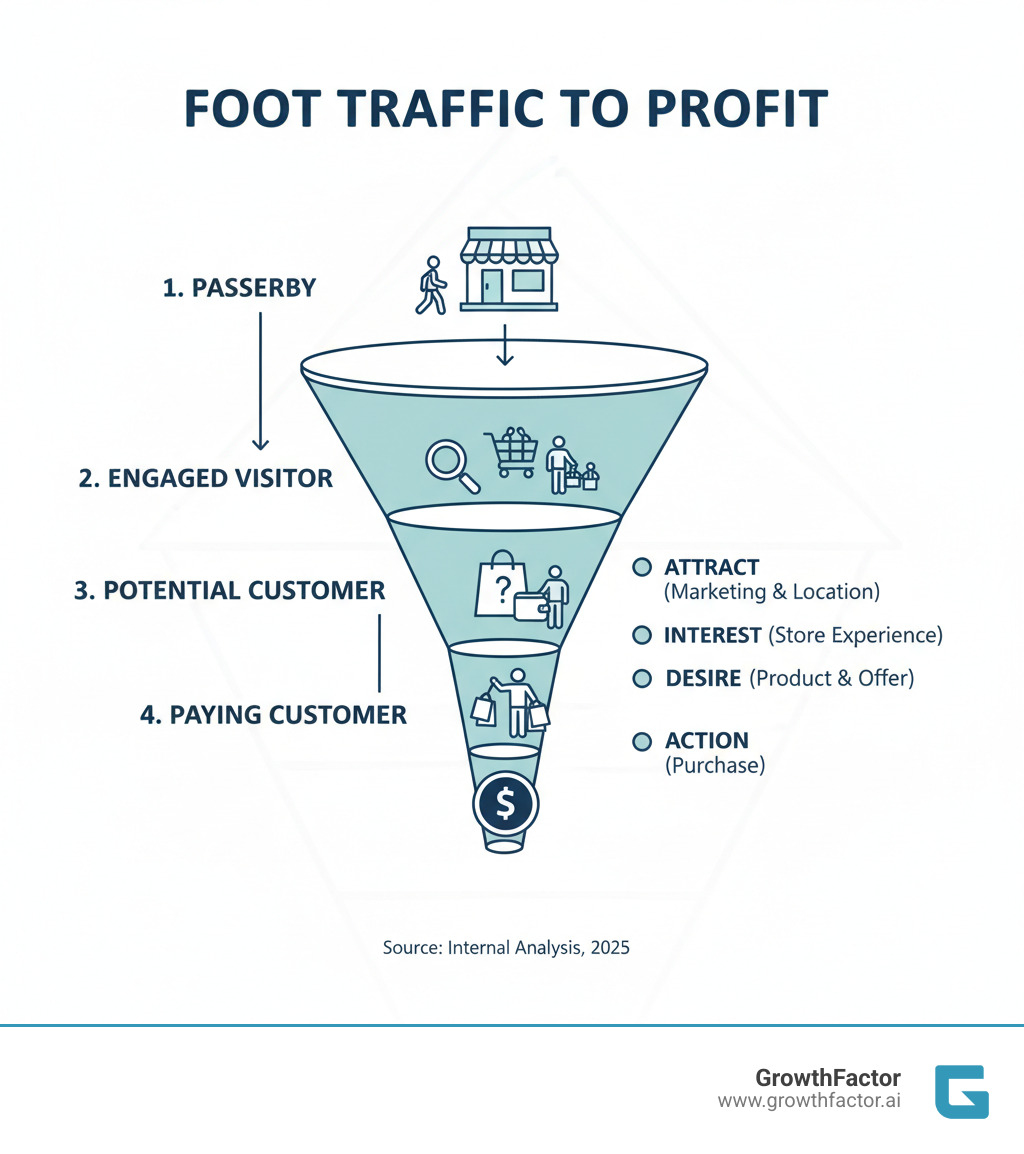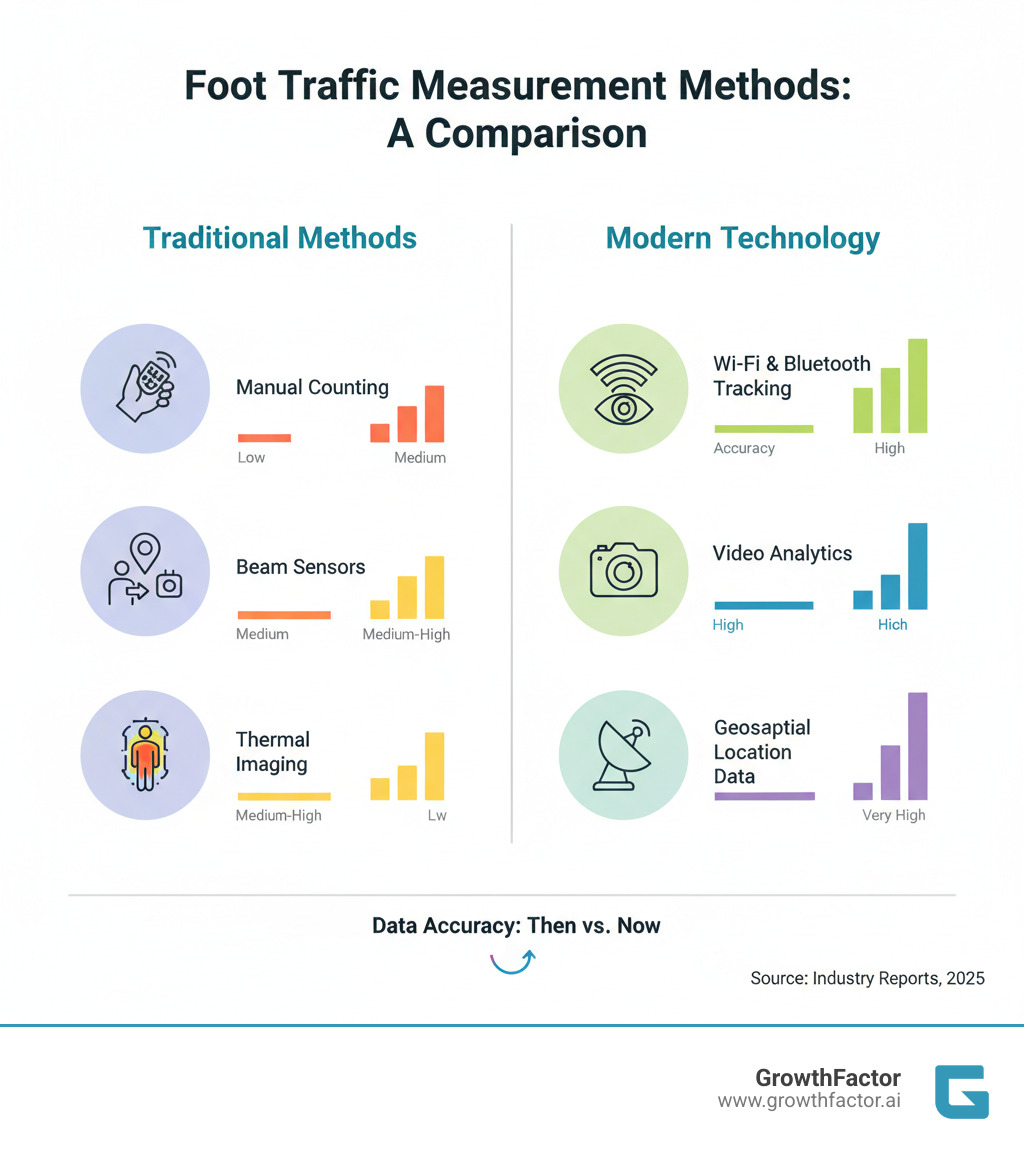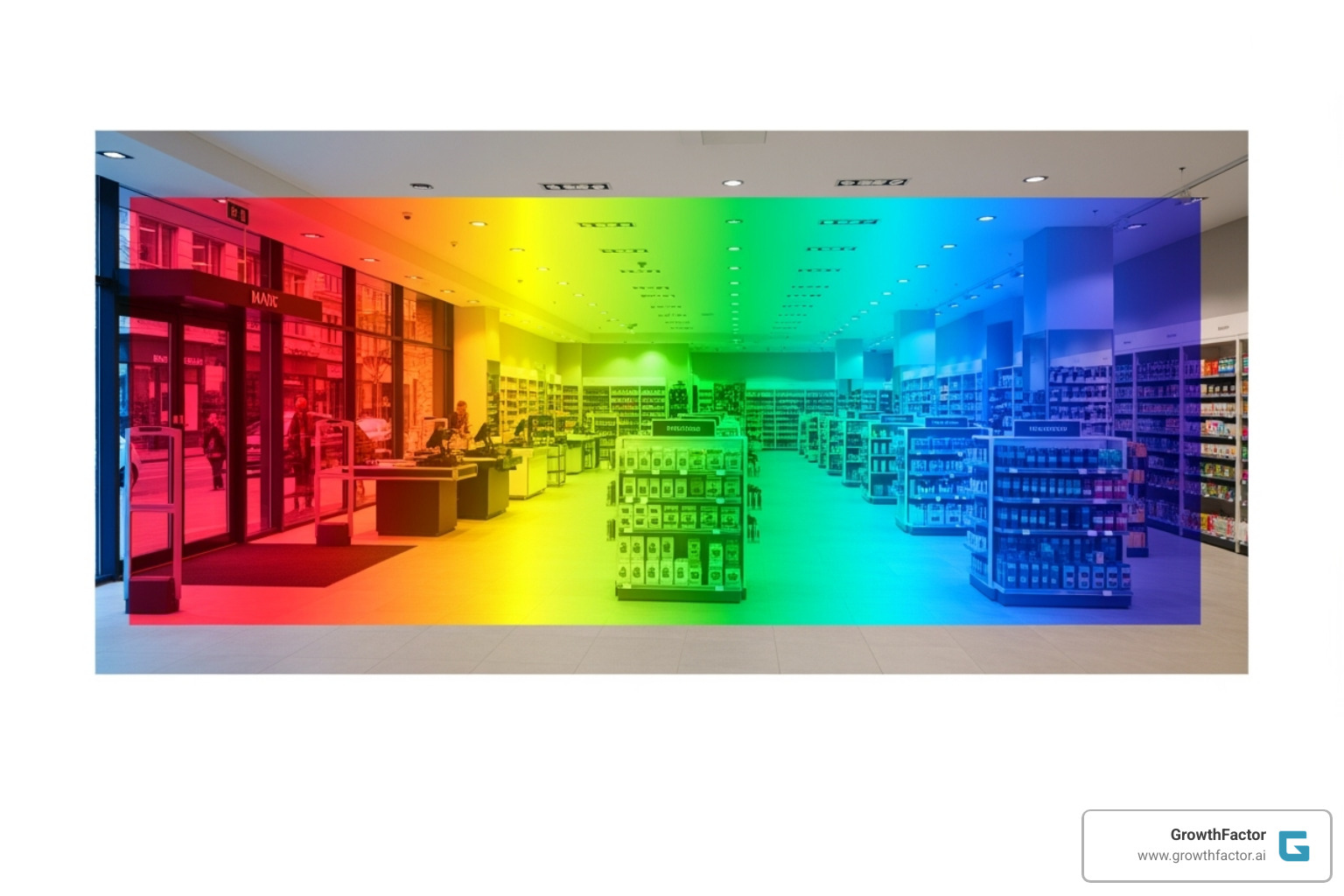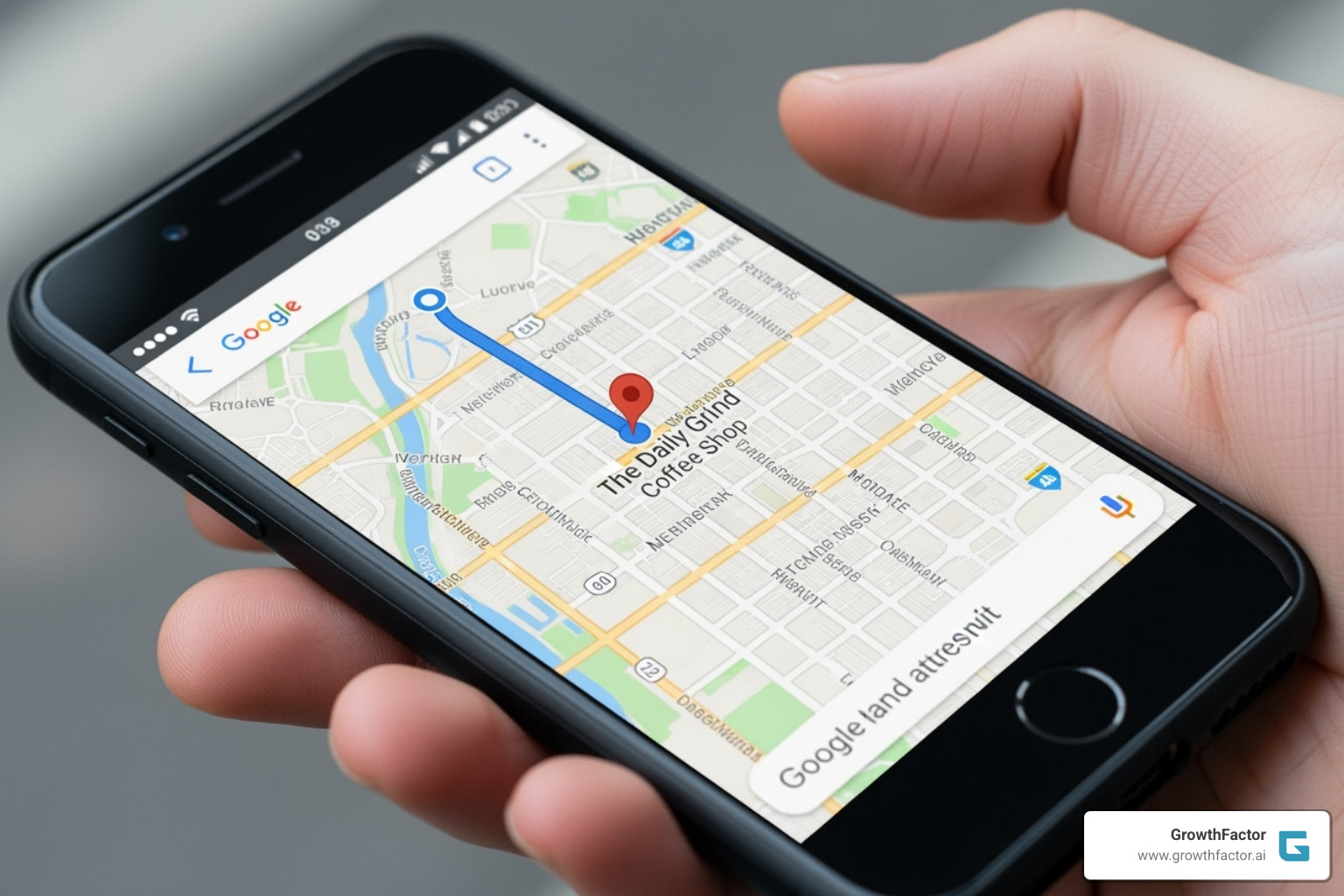The Power of Foot Traffic: What Every Retailer Needs to Know
Why Every Footstep Counts in Retail
Retail foot traffic—the measure of how many people visit a physical store—is a key indicator of a business's health and potential for success. Higher foot traffic often translates directly to more sales and revenue, making it a vital sign for any retail operation.
Understanding and growing this traffic is more important than ever. Despite the rise of e-commerce, physical stores remain critical. People still value the in-person shopping experience, but getting them through the door is just the first step. The real goal is to convert those visits into sales and build a loyal customer base.
I'm Clyde Christian Anderson, Founder and CEO of GrowthFactor.ai. With deep expertise in retail operations and real estate analysis, I'm passionate about helping retailers use data to understand and optimize retail foot traffic, making smarter location decisions to maximize their success.

Retail foot traffic vocabulary:
How to Measure and Analyze Retail Foot Traffic Data
Figuring out how many people walk into a store has evolved from a tedious task into a sophisticated science. This section explores the journey of measurement techniques, from basic manual counting to the advanced technological solutions available today.
The Evolution of Measurement Methods
Measuring retail foot traffic has come a long way from a shopkeeper with a notepad. Past and present methods range from the simple to the more advanced:
- Manual Counting: The most straightforward method involves someone physically counting each person entering the store. While low-cost, this approach is difficult to perform accurately and is prone to inconsistencies and subjectivity, especially during busy periods.
- Clicker Counters: A small step up, these devices help staff keep a running tally. They reduce miscounting but still rely on human attention, making them best for smaller businesses or short observations.
- Beam Sensors: These use an infrared beam across a doorway, registering a count when the beam is broken. However, they are often not very accurate and can produce inflated numbers from false triggers like shopping carts or pets.
- Thermal Imaging: This technology uses heat signatures to detect and count people. It offers higher accuracy than beam sensors, but the systems can be prohibitively expensive for smaller retailers.
These traditional methods often fail to provide the comprehensive, accurate, and actionable data modern retailers need. According to Walkbase, effective tracking of store traffic can significantly increase sales by helping businesses optimize store layouts, staffing, and marketing efforts. Without it, retailers miss out on crucial insights.
For a deeper dive into why this data is so vital and for an even broader understanding of tracking visitors, explore our Footfall Traffic Complete Guide.
Here's a quick look at how these methods stack up:
| Method | Accuracy | Cost | Scalability |
|---|---|---|---|
| Manual Counting | Low | Very Low | Very Low |
| Clicker Counters | Low to Medium | Low | Low |
| Beam Sensors | Medium | Low to Medium | Medium |
| Thermal Imaging | High | High | High |
| AI Video Analytics | Very High | Medium to High | High |

Leveraging Technology for Accurate Insights
The real game-changer in retail foot traffic analysis has been the leap forward in technology, allowing retailers to understand shopping habits, not just count heads. Many retailers now report using foot traffic data to optimize their operations. Modern tools provide rich, detailed data about who is visiting, when they come, and how they move within stores.
Here's how modern technology is revolutionizing measurement:
- Wi-Fi Tracking: A store's Wi-Fi network can detect signals from mobile devices to count visitors, map their paths, measure dwell time, and spot repeat visitors—all anonymously. This method offers comprehensive measurement, including duration, return visits, and even pre-visit behavior.
- Bluetooth Guides: These tiny devices send signals to Bluetooth-enabled phones, allowing for hyper-local tracking inside a store. This helps retailers understand how customers interact with specific displays or sections.
- GPS Data & Mobile Apps: With user consent, mobile apps and GPS data provide insights into where customers come from, their routes to the store, and their shopping habits at other nearby locations. This can help retailers understand customer behavior even before they enter a physical location.
- Video Analytics: Perhaps the most powerful tool, video analytics uses existing security cameras and AI to count people, create heatmaps, measure dwell times, analyze demographics, and track product engagement. AI can transform security cameras into smart tools for tracking customer movement, making it one of the easiest and most accurate methods available.
- Heatmaps: Generated from video or Wi-Fi data, heatmaps are colorful maps of your store that visually highlight areas of high and low activity. They are invaluable for optimizing store layouts and product placement.
- Dwell Time Analysis: This metric measures how long customers spend in different areas or looking at specific products. Captured by advanced sensors and video analytics, it's a key indicator of customer engagement.
- Google Maps Popular Times & Google Business Profile Insights: These free tools offer actionable insights about when a location is busiest. Retailers can see typical busy hours and days to understand general traffic patterns without installing in-store tech.
These technologies provide Real-Time Foot Traffic data, enabling quick, smart decisions. The integration of artificial intelligence is making these capabilities even more powerful. To learn more about how AI is changing retail, check out our insights on AI-Powered Retail Analytics.
Turning Data into Dollars: How to Leverage Foot Traffic Analytics
Collecting data is one thing; turning it into tangible business improvements is another. The true power of retail foot traffic analysis lies in translating data into actionable strategies that boost sales, improve the customer experience, and optimize operations.
Key Performance Indicators (KPIs) for Retail Foot Traffic
To make sense of retail foot traffic data, we must focus on specific metrics. These Key Performance Indicators (KPIs) reveal how well we're performing and where we can improve.
- Conversion Rate: This crucial KPI measures the percentage of visitors who make a purchase. It's calculated by dividing total transactions by total walk-ins. According to Retail TouchPoints, a healthy conversion rate for retail often sits between 20% and 40%, though this varies by store type. Conversion rates are more stable than raw traffic numbers, as they are less affected by external factors like local events or holidays.
- Capture Rate: For stores in a larger hub like a mall, this metric shows the percentage of the area's total foot traffic that enters your specific store. It's a great measure of your storefront's appeal.
- Dwell Time: This measures how long customers spend in your store or in specific sections. Longer dwell times often indicate higher engagement and a greater likelihood to purchase.
- Bounce Rate: This tells us how many visitors enter and leave quickly without engaging. A high bounce rate may signal issues with your store's layout, product relevance, or atmosphere.
- Peak Hours/Days: Knowing when your store is busiest helps optimize staffing, manage inventory, and time marketing efforts effectively.
- Shopper-to-Staff Ratio: This helps find the balance between having enough staff to assist customers and avoiding excessive labor costs. It's about providing excellent service efficiently.
By monitoring these KPIs, we gain a clear picture of store performance and can spot opportunities for growth. For more on these metrics, check out our guide on Foot Traffic Analytics.
Optimizing Operations and Customer Experience
With retail foot traffic data, we can make smart choices that directly impact sales and customer satisfaction.
Staffing Optimization is a primary benefit. Aligning staff schedules with peak traffic times ensures your team is ready to provide top-notch service when it matters most. It also allows for scheduling tasks like inventory during quieter periods, preventing both lost sales and wasted wages.
Data also informs Store Layout Design. Heatmaps show where customers gravitate, helping you strategically place products and signage. Research from Shopify shows that customers often look left then right upon entering, making this area prime real estate for key displays. This leads to smarter Product Placement, maximizing exposure for high-demand items and guiding shoppers to new arrivals.
Even Maintenance Schedules can be improved. Data highlights high-traffic areas that experience more wear and tear, allowing for proactive cleaning and upkeep to ensure the store always looks its best. Finally, analyzing flow around the checkout area helps improve Checkout Efficiency, minimizing wait times and preventing abandoned carts.
These optimizations create a superior customer experience. In-store analytics are a key tool for retailers looking to improve customer satisfaction. For a complete guide on perfecting your physical space, see our article on Retail Store Optimization.

Fueling Competitive Intelligence and Site Selection
Beyond daily operations, retail foot traffic data is a powerful tool for strategic growth and expansion.
It provides invaluable Competitive Intelligence, allowing you to benchmark your performance against others in the market. By analyzing traffic in your trade area, you can understand local demographics and consumer behaviors. This helps you identify audience journeys and cross-shopping patterns, revealing where your customers shop before and after visiting your store.
When expanding, this data is crucial for Minimizing Cannibalization Risk. It helps determine if a new location will attract fresh shoppers or simply divert customers from an existing store.
Most importantly, this data is the backbone of Informing Site Selection. For any growing retailer, foot traffic is fundamental to Retail Site Selection Analysis. It helps pinpoint the best locations based on demographics, psychographics, and traffic patterns to connect with your target audience.
This is where GrowthFactor shines. Our AI Agent Waldo revolutionizes Data-Driven Site Selection, empowering teams to evaluate five times more sites by automating qualification and evaluation processes, including comprehensive retail foot traffic analysis. This leads to faster, more confident decisions for your next retail locations.
Proven Strategies for Increasing Foot Traffic
Getting more people into your store requires a blend of digital marketing and in-person charm. These strategies provide a roadmap to filling your aisles with happy customers.
Digital Strategies to Drive In-Store Visits
Your online presence is often the first impression a customer has of your brand, making it a crucial driver of physical retail foot traffic. A strong online presence is key, as many shoppers find stores through local search.
Here's how to make your digital storefront shine:
- Local SEO Optimization: Ensure your business appears prominently in local search results. This means maintaining an accurate Google Business Profile with your hours, address, and phone number. High-quality photos and customer reviews are also vital, as the vast majority of consumers read online reviews before visiting a local business and trust them as much as personal recommendations.
- Google Business Profile Engagement: Don't just set up your profile and forget it. Regularly post updates about new products, promotions, or events to keep your listing fresh and engaging for potential customers.
- Social Media Engagement: Use social media to showcase products, share customer testimonials, and host live interactions. Targeted ads can reach local users who have shown interest in what you sell, nudging them toward your physical store.
- Geofencing and Location-Based Marketing: This technology allows you to send personalized promotions to potential customers' phones when they are near your store. It's an effective way to spark an impulse visit.
- Online Promotions for In-Store Redemption: Create exclusive discounts or offers that can only be redeemed by visiting your physical location. This provides a direct and compelling incentive for online browsers to become in-store shoppers.

In-Store and Community-Based Tactics
While digital strategies draw people in, the in-store experience and community involvement are what turn visitors into loyal advocates.
- Creative Window Displays: Your storefront is a 24/7 salesperson. A well-designed, regularly updated display can stop passersby in their tracks and invite them inside.
- In-Store Events and Workshops: Product launches, demonstrations, classes, or local artist showcases can transform your store into a community hub. Offering an experience, not just a transaction, is a cost-effective way to attract new visitors.
- Exclusive In-Store Products: Offering unique items or special deals that are only available in your physical store gives customers a compelling reason to make the trip.
- Loyalty Programs: Rewarding repeat customers builds strong relationships and encourages additional visits, showing appreciation for their continued business.
- Community Partnerships: Collaborating with other local businesses, charities, or organizations on joint promotions or events can introduce your store to new audiences and build goodwill.
- Pop-Up Shops: A pop-up within your store or at a local market can generate buzz and attract new faces. If you're considering this venture, our guide on Pop-Up Retail offers valuable insights.
These tactics, especially when combined with a thoughtful launch strategy detailed in our Grand Opening Ultimate Guide, create a vibrant retail environment that naturally draws people in.
The Future of Foot Traffic: Trends, Challenges, and Technology
The retail world is constantly shaped by customer desires, new technology, and global events. To succeed long-term, retailers must understand current trends, anticipate challenges, and accept innovation.
Current Trends in Retail Foot Traffic and What They Mean for 2025
Retail foot traffic patterns are always evolving. After major shifts during the pandemic, new and exciting trends have emerged.
- Hybrid Shopping Models: The line between online and in-store shopping has blurred. Customers expect seamless experiences like "buy online, pick up in-store" (BOPIS) and curbside pickup, requiring physical stores to integrate tightly with their digital counterparts.
- "Retail-tainment": Shopping is becoming an experience. Malls and stores are changing into destinations for entertainment and dining, reflecting a consumer desire for engaging activities.
- Sustainability as a Draw: Consumers are increasingly making purchasing decisions based on environmental values. Retailers who demonstrate a commitment to sustainability can attract like-minded visitors.
- Dynamic Peak Times: Remote work and flexible schedules are shifting traditional busy hours. Retailers need to be agile with staffing and promotions to adapt to these new patterns.
- Value-Oriented Spending: In uncertain economic times, consumers often seek out the best deals. In 2024, discount and dollar stores saw significant visit growth, highlighting the importance of value.
Despite these shifts, physical retail remains resilient, as evidenced by the fact that retail sales in the U.S. actually increased by 2.3% year-on-year in May 2024 (see the U.S. Census retail sales report). Adapting to these trends is crucial. To dive deeper into how online and offline worlds are merging, check out The New Retail Paradox: When Physical Meets Digital.
Challenges and Limitations in Foot Traffic Analysis
While analyzing retail foot traffic is beneficial, it's important to be aware of potential challenges.
- Data Accuracy: Achieving perfect accuracy can be difficult. Factors like store lighting, weather, or extreme crowding can affect measurement tools. Differentiating between customers, staff, and delivery personnel can also be a challenge.
- Privacy Concerns: Using advanced tracking tools like Wi-Fi or GPS requires a strong commitment to privacy. Retailers must comply with data protection laws and anonymize data to respect customer privacy, an important ethical consideration when using powerful tools like AI for Real Estate.
- Cost of Technology: The initial investment for advanced sensors, video analytics, or data platforms can be significant, which may be a barrier for smaller businesses.
- Data Overload and Interpretation: Modern tools can generate an overwhelming amount of data. Without the right analytics capabilities, it can be difficult to extract actionable insights. This is where smart AI-Driven Analytics become invaluable, helping to make sense of complex information.
Overcoming these challenges requires careful planning, choosing the right tools, and a commitment to continuous learning and adaptation.
Frequently Asked Questions about Retail Foot Traffic
You've journeyed with us through the ins and outs of retail foot traffic, from its definition to advanced analytics and future trends. Now, let's tackle some of the most common questions that pop up when retailers like you are looking to make every step count!
What is a good foot traffic conversion rate for retail?
A good retail foot traffic conversion rate can vary, but a healthy range for physical retail stores typically falls between 20% and 40%.
What's "good" depends on several factors:
- Your Industry: A high-end jewelry store will have a different buying cycle than a grocery store.
- Product Type: Stores selling necessities may see higher conversion than those with niche luxury items.
- Store Location: A busy mall kiosk will likely have a different conversion rate than a standalone boutique.
The conversion rate is a much more stable metric than raw foot traffic. External factors like a holiday parade or bad weather might change the number of people who walk by, but the percentage of those who do enter and buy often remains more consistent. It helps you understand your store's effectiveness once customers are inside.
How does store layout affect foot traffic patterns?
Your store's layout is a silent guide that directly influences how customers move and interact with your products.
When shoppers enter a store, many have a natural tendency to look left and then right. This insight is incredibly powerful, as it allows you to strategically place eye-catching displays or new arrivals in their initial line of sight.
This is where tools like heatmaps (visual representations of high-traffic zones) become invaluable. By understanding where people naturally go and linger, you can:
- Place high-margin products where they're most likely to be seen.
- Position popular items to draw customers deeper into the store.
- Design promotional displays that guide shoppers along a desired path.
A well-designed layout crafts an intuitive customer journey, making shopping a more enjoyable and productive experience.
Can I measure foot traffic for free?
Absolutely! While advanced solutions offer incredible depth, you can start understanding your retail foot traffic without a budget.
Here are a couple of free methods:
- Manual Counting Methods: The traditional approach of having a team member count people as they enter and exit can provide a baseline understanding of your busiest hours and days. This is best for smaller operations or short-term observations.
- Google Business Profile "Popular Times" Data: If you have a Google Business Profile, Google provides a "Popular Times" feature. It shows your typical busy hours based on anonymous location data, giving you a glimpse into your store's activity patterns.
While these free methods lack the granular detail of AI-powered analytics, they offer valuable initial insights into your traffic patterns. They can help you identify trends and start thinking strategically before investing in more precise, paid solutions.
Conclusion: Making Every Visitor a Valuable Opportunity
So, we've journeyed through the fascinating world of retail foot traffic, from its basic definition to the cutting-edge ways we can measure and use it. It's clear now, isn't it? Understanding who walks through your doors, and why, is absolutely essential in today's retail landscape. It's no longer just a nice-to-have; it's a fundamental part of staying ahead and thriving.
We've moved so far beyond simple clicker counters. Now, with sophisticated analysis, businesses can truly transform. Imagine making your store a happier place for customers, running things smoother behind the scenes, and making incredibly smart choices about everything from who's on the floor to your overall Store Location Strategy. All of this comes from diving deep into what your foot traffic data tells you.
And this is where cutting-edge tools come into play. Embracing AI-powered platforms like GrowthFactor can really amplify these efforts. It’s like having a super-smart assistant that takes all that raw data and turns it into a powerful engine for growth. By focusing on the insights that retail foot traffic provides, you're not just counting footsteps; you're ensuring every single step a customer takes inside your store is a step toward greater profitability. Ready to make those steps count? Learn how GrowthFactor can help your site selection team.
Citations
The human algorithm
Request Your demo
Schedule meeting
Or submit your information below and we'll be in touch to schedule.




